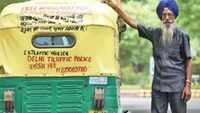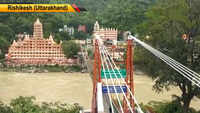
Nagpur: Nagpur University continues to be targeted by various groups for including Rashtriya Swayamsevak Sangh (RSS) as a topic in BA fourth semester syllabus. The book, which is recommended by the varsity’s Board of Studies (BOS), reveals the reason of Sangh’s formation and its working between 1925 and 1947. Most of the contents are from the books written by late Sharad Kolarkar, the former head of history department.
From ‘Adhunik Vidarbhachya Itihas (Modern Vidarbha’s History)’, NU recommended three pages on chapter related to RSS establishment and how it spread in the initial years. It informs about many interesting facets, including circumstances that led founder Keshav Hedgewar, then a senior Congress activist, to form the Sangh.
Hedgewar was instrumental in setting up ‘Bharat Swayamsevak Mandal’ to train activists for preparation of Indian National Congress (INC) session held in Nagpur in 1920. That time, Hedgewar along with BS Munje had toured entire Vidarbha and called on the citizens to fight against the British government. Subsequently, Hedgewar was sentenced to one year of rigorous imprisonment.
When he was released, Hedgewar saw Congress’s inclination towards Muslims by extending full support to the Khilafat movement. He always held the opinion that intellectuals from the region helping Muslim community members may be detrimental to the society and it was not going to resolve differences between the two communities. Hedgewar then left the Congress in frustration and decided to form RSS.
According to Kolarkar, Hedgewar’s objective was to promote unity among various Hindu groups and inculcate a sense of patriotism among them. He believed that the saffron organization would resolve all problems plaguing the society.
The Sangh was formally established on the occasion of Dussehera in 1925 by unfurling a saffron flag at Mohite Wada. After that, the saffron organization rapidly spread it branches in entire country. The book mentions that with a “noble objective” of uniting Hindus, Hedgewar focused on character building and called on people to join the Shakhas for at least one hour in a day.
Hedgewar was of opinion that if people from all castes, sub-castes and creed, came together under the one platform for a “nation” then it would lead to abolishing casteism from the society and they would become patriots.
Kolarkar wrote that Hedgewar’s thoughts had left a deep impact on the Vidarbha’s history. Many motivated youngsters joined him in the drive and spread to all areas in Vidarbha to propagate his ideology. They braved all odds and made many sacrifices to spread Sangh presence in rural areas.
The book further talks about satyagrah against Arms Prevention Act of British by General Mancharsha Awari. During a protest against the Act, the British arrested some RSS activists, who were having swords in the hands and sent them to four years of RI on May 24, 1998. Hedgewar then directed his activists to use dummy weapons.
“Our broader objective was to inform the students on RSS formative years, so that they could understand it better when they study about in MA course. We’ve recommended basic information about Sangh in BA and therefore very few contents from Kolarkar’s books were recommended,” NU BOS chairman Shyam Koretti, told TOI, reiterating that unnecessary fuss was being created on small issue.
ABOUT THE BOOK
* From Kolarkar’s book ‘Adhunik Vidarbhachya Itihas’, NU recommended three pages on chapter related to RSS establishment
* It informs about many interesting facets, including circumstances that led founder Keshav Hedgewar, then senior Congress activist, to form Sangh
* Hedgewar was instrumental in setting up ‘Bharat Swayamsevak Mandal’ to train activists for preparation of Indian National Congress (INC) session in Nagpur in 1920
* He was upset with Congress’ inclination towards Muslims by extending full support to the Khilafat movement
* His objective behind RSS formation was to promote unity among various Hindu groups and inculcate sense of patriotism among them
From ‘Adhunik Vidarbhachya Itihas (Modern Vidarbha’s History)’, NU recommended three pages on chapter related to RSS establishment and how it spread in the initial years. It informs about many interesting facets, including circumstances that led founder Keshav Hedgewar, then a senior Congress activist, to form the Sangh.
Hedgewar was instrumental in setting up ‘Bharat Swayamsevak Mandal’ to train activists for preparation of Indian National Congress (INC) session held in Nagpur in 1920. That time, Hedgewar along with BS Munje had toured entire Vidarbha and called on the citizens to fight against the British government. Subsequently, Hedgewar was sentenced to one year of rigorous imprisonment.
When he was released, Hedgewar saw Congress’s inclination towards Muslims by extending full support to the Khilafat movement. He always held the opinion that intellectuals from the region helping Muslim community members may be detrimental to the society and it was not going to resolve differences between the two communities. Hedgewar then left the Congress in frustration and decided to form RSS.
According to Kolarkar, Hedgewar’s objective was to promote unity among various Hindu groups and inculcate a sense of patriotism among them. He believed that the saffron organization would resolve all problems plaguing the society.
The Sangh was formally established on the occasion of Dussehera in 1925 by unfurling a saffron flag at Mohite Wada. After that, the saffron organization rapidly spread it branches in entire country. The book mentions that with a “noble objective” of uniting Hindus, Hedgewar focused on character building and called on people to join the Shakhas for at least one hour in a day.
Hedgewar was of opinion that if people from all castes, sub-castes and creed, came together under the one platform for a “nation” then it would lead to abolishing casteism from the society and they would become patriots.
Kolarkar wrote that Hedgewar’s thoughts had left a deep impact on the Vidarbha’s history. Many motivated youngsters joined him in the drive and spread to all areas in Vidarbha to propagate his ideology. They braved all odds and made many sacrifices to spread Sangh presence in rural areas.
The book further talks about satyagrah against Arms Prevention Act of British by General Mancharsha Awari. During a protest against the Act, the British arrested some RSS activists, who were having swords in the hands and sent them to four years of RI on May 24, 1998. Hedgewar then directed his activists to use dummy weapons.
“Our broader objective was to inform the students on RSS formative years, so that they could understand it better when they study about in MA course. We’ve recommended basic information about Sangh in BA and therefore very few contents from Kolarkar’s books were recommended,” NU BOS chairman Shyam Koretti, told TOI, reiterating that unnecessary fuss was being created on small issue.
ABOUT THE BOOK
* From Kolarkar’s book ‘Adhunik Vidarbhachya Itihas’, NU recommended three pages on chapter related to RSS establishment
* It informs about many interesting facets, including circumstances that led founder Keshav Hedgewar, then senior Congress activist, to form Sangh
* Hedgewar was instrumental in setting up ‘Bharat Swayamsevak Mandal’ to train activists for preparation of Indian National Congress (INC) session in Nagpur in 1920
* He was upset with Congress’ inclination towards Muslims by extending full support to the Khilafat movement
* His objective behind RSS formation was to promote unity among various Hindu groups and inculcate sense of patriotism among them
World Cup 2019
Trending Topics
LATEST VIDEOS
More from TOI
Navbharat Times
Featured Today in Travel
Quick Links
Lok Sabha Election Schedule 2019Lok Sabha Election NewsDelhi Capitals teamMI team 2019Rajasthan Royals 2019RCB team 2019Maharashtra Lok Sabha ConstituenciesBJP Candidate ListBJP List 2019 TamilnaduShiv Sena List 2019AP BJP List 2019Mamata BanerjeeBJP List 2019 MaharashtraPriyanka GandhiBJP List 2019 KarnatakaAMMK Candidate List 2019BJP List 2019 WBLok Sabha Elections in Tamil NaduBSP List 2019 UPNews in TamilLok Sabha Poll 2019Satta Matka 2018PM ModiMahagathbandhanNagpur BJP Candidate ListChandrababu NaiduTamil Nadu ElectionsUrmila MatondkarNews in TeluguMadras High CourtTejashwi YadavArvind KejriwalTejasvi SuryaPawan KalyanArvind KejriwalYogi AdityanathJaya PradaSatta King 2019Srinagar encounter
Get the app







